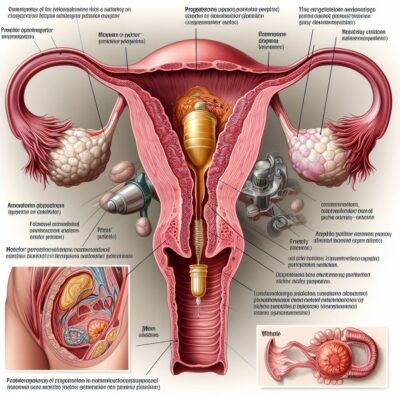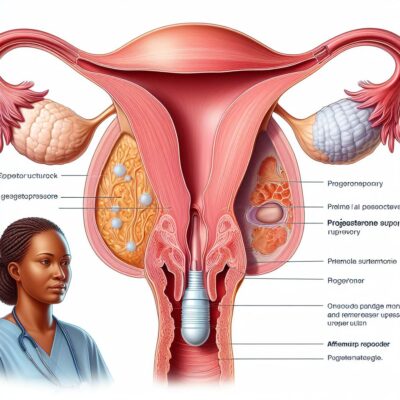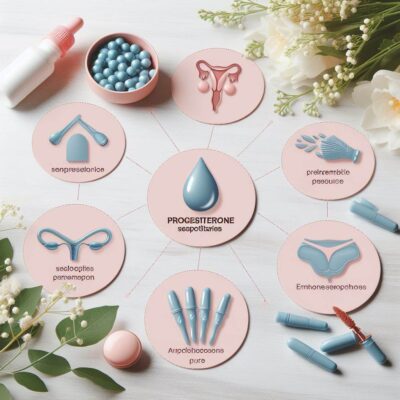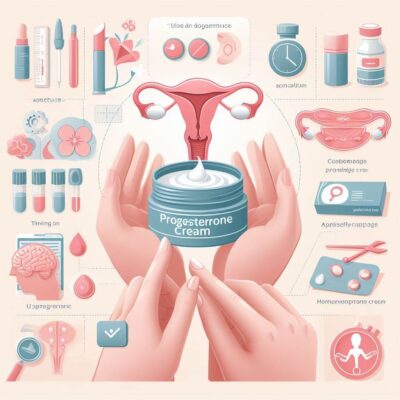
Navigating fertility treatments and hormone therapy can be a complex journey, often accompanied by questions and concerns about potential side effects. Among the inquiries frequently raised is whether progesterone suppositories, a common component of such treatments, can cause cramping.
The relationship between progesterone suppositories and cramping is essential for individuals undergoing reproductive health interventions, allowing them to anticipate and address potential discomfort. In this article, we delve into this specific question, “Do Progesterone Suppositories Cause Cramping” & exploring the nuanced interplay between progesterone supplementation and cramping.
By providing insights into this topic, we aim to offer clarity and reassurance to individuals embarking on fertility treatments or hormone therapy, empowering them to make informed decisions about their reproductive health.
Do Progesterone Suppositories Cause Cramping

Progesterone suppositories are often prescribed as part of fertility treatments or hormone replacement therapy to support reproductive health. Here’s a detailed exploration of whether they can cause cramping:
1. Potential for Mild Cramping:
Progesterone, a hormone known for its role in supporting pregnancy, can have a relaxing effect on the muscles, including those of the uterus. As a result, some individuals may experience mild cramping or discomfort as the uterus adjusts to the hormonal changes induced by progesterone supplementation.
2. Transient Effects:
Cramping associated with progesterone suppositories is typically transient and short-lived. It may occur sporadically and is often mild in nature, resembling menstrual cramps or abdominal discomfort.
3. Individual Sensitivity:
The likelihood and severity of cramping can vary among individuals, depending on factors such as dosage, frequency of use, and individual sensitivity to progesterone. Some individuals may be more prone to experiencing cramping than others.
4. Early Pregnancy Symptoms:
In the context of fertility treatments, cramping may also occur as an early pregnancy symptom. Progesterone supplementation is commonly used to support the early stages of pregnancy, and cramping may be a sign of implantation or uterine changes associated with pregnancy.
5. Treatment Adjustments:
Healthcare providers may adjust the progesterone dosage or treatment protocol based on individual responses and treatment goals to minimize discomfort while optimizing therapeutic outcomes. Adjustments may include altering the timing of suppository administration or exploring alternative progesterone delivery methods.
6. Monitoring and Communication:
Individuals using progesterone suppositories should monitor their symptoms closely and communicate any concerns or discomfort to their healthcare provider. Open communication allows healthcare providers to provide guidance, reassurance, and adjustments to the treatment plan as needed.
7. Management Strategies:
Individuals experiencing cramping related to progesterone suppository use can employ management strategies to alleviate discomfort. These may include gentle abdominal massage, application of heat packs, and over-the-counter pain relievers (if approved by a healthcare provider).
Summary: While progesterone suppositories may occasionally cause mild cramping as a side effect, it is typically transient and manageable. Understanding the factors contributing to cramping and maintaining open communication with healthcare providers is key to navigating progesterone supplementation with confidence and comfort. I hope now you’re aware of Do Progesterone Suppositories Cause Cramping.
Why Is Progesterone Suppositories Important?

Within the intricate landscape of reproductive health and fertility treatments, progesterone suppositories emerge as a crucial tool in supporting pregnancy and hormonal balance.
These pharmaceutical formulations, administered vaginally, play a significant role in supplementing natural progesterone levels in the body, particularly during critical phases of the menstrual cycle and early pregnancy.
Understanding the importance of progesterone suppositories is essential for individuals navigating fertility treatments or managing hormonal imbalances, as they offer insights into the therapeutic significance and clinical relevance of these medications.
Exploring progesterone suppositories’ pivotal role in reproductive health, fertility treatments, and hormone replacement therapy. By shedding light on this topic, we aim to underscore the importance of progesterone supplementation in supporting optimal reproductive outcomes and empowering individuals to make informed decisions about their healthcare journey.
Guide:
Progesterone suppositories hold significant importance in the realm of reproductive health and fertility treatments for several reasons:
1. Supporting Pregnancy:
Progesterone is essential for maintaining pregnancy by supporting the development of the uterine lining and preventing its shedding, which could result in miscarriage. Progesterone suppositories provide supplemental progesterone to ensure adequate support for early pregnancy and reduce the risk of miscarriage, particularly in individuals with progesterone deficiency or a history of pregnancy loss.
2. Fertility Treatments:
In assisted reproductive technologies such as in vitro fertilization (IVF) or intrauterine insemination (IUI), progesterone suppositories are commonly used to support embryo implantation and early pregnancy. They help prepare the uterine lining for implantation and provide hormonal support during the critical luteal phase of the menstrual cycle.
3. Hormone Replacement Therapy:
Progesterone suppositories are also utilized in hormone replacement therapy to supplement progesterone levels in individuals with hormonal imbalances or irregular menstrual cycles. They help regulate the menstrual cycle, alleviate symptoms of hormonal deficiency, and support overall reproductive health.
4. Minimizing Pregnancy Complications:
Adequate progesterone levels are crucial for reducing the risk of pregnancy complications such as preterm birth, preeclampsia, and gestational diabetes. Progesterone suppositories help maintain optimal progesterone levels throughout pregnancy, thereby mitigating the risk of these complications and promoting better maternal and fetal outcomes.
5. Personalized Treatment Approach:
Progesterone suppositories offer a personalized treatment approach tailored to individual needs and treatment goals. Healthcare providers can adjust the progesterone dosage, treatment duration, and monitoring plan based on each patient’s unique medical history, fertility status, and treatment response.
6. Improving Reproductive Outcomes:
By ensuring adequate progesterone support during critical phases of the menstrual cycle and early pregnancy, progesterone suppositories contribute to improved reproductive outcomes, including higher pregnancy rates, lower miscarriage rates, and healthier pregnancies.
Summary:
progesterone suppositories play a vital role in supporting pregnancy, fertility treatments, and hormone replacement therapy by providing supplemental progesterone to individuals with hormonal imbalances or reproductive challenges.
Understanding the importance of progesterone suppositories is essential for individuals navigating fertility treatments or managing hormonal imbalances, as they offer a personalized and targeted approach to optimizing reproductive outcomes and promoting overall reproductive health.
Progesterone Vaginal Side Effects

In the realm of reproductive health and hormone therapy, progesterone vaginal suppositories are a common pharmaceutical intervention used to support fertility treatments, regulate menstrual cycles, and maintain pregnancy.
While these suppositories offer significant therapeutic benefits, it’s essential to understand the potential side effects associated with their use. This article delves into the topic of progesterone vaginal side effects, exploring the range of possible reactions individuals may experience while using these medications.
Side Effects:
Progesterone vaginal suppositories may cause various side effects in some individuals. Here’s a detailed overview of potential side effects associated with their use:
1. Vaginal Discharge:
One of the most common side effects of progesterone vaginal suppositories is vaginal discharge. This discharge may be white, creamy, or slightly yellowish in color and is typically a result of the suppository’s base material.
2. Vaginal Irritation:
Some individuals may experience vaginal irritation or discomfort while using progesterone vaginal suppositories. This irritation may manifest as itching, burning, or redness in the vaginal area.
3. Mild Abdominal Discomfort:
Mild abdominal discomfort or bloating may occur as a side effect of progesterone vaginal suppositories. This discomfort is often transient and typically resolves on its own.
4. Breast Tenderness:
Progesterone supplementation can sometimes lead to breast tenderness or enlargement due to hormonal fluctuations. This side effect is more commonly observed in individuals with higher progesterone levels.
5. Mood Changes:
Some individuals may experience mood changes or emotional fluctuations while using progesterone vaginal suppositories. These changes may include mood swings, irritability, or feelings of sadness.
6. Headaches:
Headaches or migraines may occur as a side effect of progesterone supplementation. These headaches are typically mild to moderate in intensity and may resolve with time or with the discontinuation of the medication.
7. Nausea or Vomiting:
Nausea or vomiting may occur in some individuals as a side effect of progesterone vaginal suppositories. These gastrointestinal symptoms are usually mild and transient but may require medical attention if severe or persistent.
8. Allergic Reactions:
In rare cases, individuals may experience allergic reactions to progesterone vaginal suppositories. Symptoms of an allergic reaction may include rash, itching, swelling, or difficulty breathing and require immediate medical attention.
9. Changes in Libido:
Progesterone supplementation can sometimes affect libido or sexual desire in some individuals. Changes in libido may manifest as increased or decreased interest in sexual activity.
10. Menstrual Changes:
Progesterone vaginal suppositories may also cause changes in menstrual patterns, including irregular bleeding or spotting between periods. These changes are typically temporary and resolve once progesterone supplementation is discontinued.
Serious Side Effects Of Progesterone Suppositories

As with any medication, it’s crucial to be aware of the potential for serious side effects when using progesterone supplements, especially those administered vaginally.
While progesterone is generally well-tolerated and offers significant therapeutic benefits in managing reproductive health conditions, serious side effects can occur in some individuals. Understanding these risks is essential for making informed decisions about treatment and ensuring timely medical intervention if needed.
In this article, we delve into the topic of serious side effects associated with progesterone supplementation, providing insights into the rare but significant adverse reactions that individuals may experience. By highlighting these potential risks, we aim to promote awareness and empower individuals to prioritize their health and well-being when considering progesterone therapy.
Side Effects:
1. Allergic Reactions:
In some cases, individuals may experience severe allergic reactions to progesterone supplements. Symptoms of an allergic reaction may include rash, itching, swelling of the face, lips, tongue, or throat, difficulty breathing, or chest tightness. Anaphylaxis, a life-threatening allergic reaction, requires immediate medical attention.
2. Blood Clots:
Progesterone supplementation, especially in high doses or in individuals with preexisting risk factors, may increase the risk of blood clots. Blood clots can lead to serious complications such as deep vein thrombosis (DVT), pulmonary embolism (PE), or stroke.
Symptoms of a blood clot may include swelling, pain, warmth, or redness in the affected area, difficulty breathing, chest pain, or sudden weakness or numbness.
3. Liver Damage:
Rarely, progesterone supplements may cause liver damage or liver dysfunction. Signs of liver damage may include yellowing of the skin or eyes (jaundice), dark urine, light-colored stools, abdominal pain, nausea, vomiting, or fatigue. Prompt medical evaluation is necessary if any symptoms of liver damage occur.
4. Cardiovascular Events:
Progesterone supplementation may increase the risk of cardiovascular events, particularly in individuals with underlying heart disease or risk factors such as hypertension or diabetes.
Serious cardiovascular events may include heart attack, stroke, or cardiac arrhythmias. Symptoms of a cardiovascular event may include chest pain, shortness of breath, dizziness, fainting, or palpitations.
5. Severe Mood Changes:
While mood changes are a common side effect of progesterone supplementation, severe or persistent mood changes such as depression, anxiety, or suicidal thoughts require immediate medical attention. These symptoms may indicate a serious underlying condition that requires prompt intervention and treatment.
6. Pregnancy Complications:
In rare cases, progesterone supplements may increase the risk of certain pregnancy complications, such as ectopic pregnancy or molar pregnancy. These conditions require medical evaluation and management to prevent serious health consequences for both the mother and the fetus.
7. Vision Changes:
Progesterone supplementation may rarely cause vision changes or visual disturbances such as blurred vision, double vision, or changes in color perception. These symptoms may indicate a serious ocular condition requiring prompt evaluation by an eye care specialist.
8. Respiratory Complications:
Severe respiratory complications, such as acute respiratory distress syndrome (ARDS) or pulmonary edema, may rarely occur as a result of progesterone supplementation. Symptoms may include severe shortness of breath, rapid breathing, chest pain, or cyanosis (bluish discoloration of the skin). Immediate medical attention is necessary in such cases.
While serious side effects associated with progesterone supplementation are rare, it’s essential for individuals to be aware of these potential risks and to seek prompt medical attention if they experience any concerning symptoms.
By monitoring for signs of serious side effects and maintaining open communication with healthcare providers, individuals can ensure timely intervention and appropriate management to safeguard their health and well-being.
Benefits Of Progesterone Suppositories

Progesterone suppositories serve as a valuable tool in supporting pregnancy, regulating menstrual cycles, and managing hormonal imbalances. These pharmaceutical formulations, typically administered vaginally, offer a range of therapeutic benefits for individuals seeking to optimize their reproductive health outcomes.
While progesterone supplementation may involve some risks and side effects, understanding the potential benefits is crucial for individuals navigating fertility treatments or hormone therapy. In this article, we explore the myriad advantages of progesterone suppositories, shedding light on their role in promoting reproductive well-being and supporting individuals on their healthcare journey.
By highlighting these benefits, we aim to provide comprehensive insights into the therapeutic value of progesterone supplementation, empowering individuals to make informed decisions about their reproductive health.
Benefits:
1. Supports Pregnancy:
Progesterone is crucial for maintaining pregnancy by supporting the development of the uterine lining and preventing its shedding, which could lead to miscarriage.
Progesterone suppositories provide supplemental progesterone to ensure adequate support for early pregnancy, reducing the risk of miscarriage in individuals with progesterone deficiency or a history of pregnancy loss.
2. Promotes Embryo Implantation:
During assisted reproductive technologies such as in vitro fertilization (IVF) or intrauterine insemination (IUI), progesterone suppositories play a vital role in preparing the uterine lining for embryo implantation.
By promoting optimal endometrial receptivity, progesterone supplementation enhances the chances of successful embryo implantation and pregnancy.
3. Regulates Menstrual Cycles:
Progesterone suppositories are used to regulate menstrual cycles and manage irregular bleeding or amenorrhea (absence of menstruation) caused by hormonal imbalances.
By restoring progesterone levels during the luteal phase of the menstrual cycle, progesterone supplementation helps maintain a regular menstrual cycle and promote hormonal balance.
4. Reduces Symptoms of Hormonal Imbalance:
Progesterone supplementation can alleviate symptoms associated with hormonal imbalances, such as irregular menstrual cycles, mood swings, breast tenderness, and bloating. By restoring hormonal equilibrium, progesterone suppositories improve overall well-being and quality of life for individuals experiencing hormonal fluctuations.
5. Minimizes Pregnancy Complications:
Adequate progesterone support during pregnancy is essential for reducing the risk of certain pregnancy complications, such as preterm birth, preeclampsia, and gestational diabetes.
Progesterone suppositories help maintain optimal progesterone levels throughout pregnancy, thereby mitigating the risk of these complications and promoting better maternal and fetal outcomes.
6. Facilitates Hormone Replacement Therapy:
Progesterone suppositories are utilized in hormone replacement therapy to supplement progesterone levels in individuals with hormonal deficiencies or irregular menstrual cycles.
By restoring progesterone levels to normal physiological ranges, progesterone supplementation helps regulate the menstrual cycle, alleviate symptoms of hormonal deficiency, and support overall reproductive health.
7. Personalized Treatment Approach:
Progesterone suppositories offer a personalized treatment approach tailored to individual needs and treatment goals. Healthcare providers can adjust the progesterone dosage, treatment duration, and monitoring plan based on each patient’s unique medical history, fertility status, and treatment response, ensuring optimal therapeutic outcomes.
8. Improves Reproductive Outcomes:
By supporting pregnancy, enhancing embryo implantation, regulating menstrual cycles, and minimizing pregnancy complications, progesterone suppositories contribute to improved reproductive outcomes, including higher pregnancy rates, lower miscarriage rates, and healthier pregnancies.
Summary:
progesterone suppositories offer a range of therapeutic benefits for individuals seeking to optimize their reproductive health and fertility outcomes. By providing supplemental progesterone support, these medications promote pregnancy success, regulate menstrual cycles, alleviate symptoms of hormonal imbalance, and minimize pregnancy complications.
Understanding the benefits of progesterone suppositories is essential for individuals navigating fertility treatments or hormone therapy, as it empowers them to make informed decisions about their reproductive health and well-being.
Does Progesterone Cause Cramping In Early Pregnancy?

The journey through early pregnancy is often accompanied by a multitude of physical and emotional changes, including the occasional occurrence of symptoms like cramping. Among the various factors contributing to these sensations, the role of progesterone, a vital hormone in pregnancy maintenance, is often questioned.
Understanding whether progesterone causes cramping in early pregnancy is essential for expectant individuals, as it helps alleviate concerns and enables informed discussions with healthcare providers. In this article, we explore this topic in depth, shedding light on the relationship between progesterone and cramping during the early stages of pregnancy.
By providing clarity on this matter, we aim to support individuals on their journey towards parenthood, fostering confidence and peace of mind during this transformative period.
Cause Cramping In Early Pregnancy:
1. Natural Uterine Changes:
Cramping is a common symptom experienced by many individuals in early pregnancy. During this time, the uterus undergoes significant changes to accommodate the developing fetus. Progesterone, a hormone essential for maintaining pregnancy, can contribute to these changes by causing relaxation of uterine muscles.
2. Implantation Process:
Cramping may also occur as a result of the implantation process, during which the fertilized egg attaches itself to the uterine lining. Progesterone supports this crucial stage of pregnancy by promoting a receptive uterine environment for implantation, and mild cramping may be a sign of this process taking place.
3. Uterine Blood Flow:
Progesterone plays a role in increasing blood flow to the uterus, ensuring adequate oxygen and nutrient supply to the developing embryo. While this is essential for a healthy pregnancy, it can also contribute to sensations of mild discomfort or cramping as the uterus adapts to increased blood circulation.
4. Individual Variability:
The experience of cramping in early pregnancy can vary widely among individuals. Factors such as hormonal fluctuations, uterine sensitivity, and individual pain thresholds contribute to this variability. While some individuals may experience minimal or no cramping, others may notice more pronounced sensations.
5. Differentiation from Concerning Symptoms:
It’s important for individuals experiencing cramping in early pregnancy to differentiate between normal, mild cramping and more concerning symptoms.
While mild cramping is often a natural part of the pregnancy process, severe or persistent cramping, particularly when accompanied by vaginal bleeding or other worrisome symptoms, may indicate a potential complication and should prompt immediate medical attention.
6. Monitoring and Communication:
Expectant individuals are encouraged to monitor their symptoms closely and communicate any concerns or discomfort to their healthcare provider. Open communication allows healthcare providers to offer guidance, reassurance, and appropriate management strategies tailored to individual needs.
Summary:
While progesterone plays a crucial role in early pregnancy and may contribute to mild cramping due to its effects on uterine relaxation and the implantation process, it is typically a natural and harmless phenomenon. Understanding the nuances of progesterone’s role in pregnancy and being aware of the factors influencing cramping can help individuals navigate this aspect of early pregnancy with confidence and peace of mind.
How Should I Use Progesterone Vaginal?

Navigating the realm of hormonal supplementation, particularly when it involves intimate administration methods like vaginal application, can be daunting for individuals seeking to optimize their reproductive health or manage hormonal imbalances.
Progesterone vaginal supplementation is a common practice in fertility treatments, hormone replacement therapy, and pregnancy support, offering targeted delivery of this essential hormone. However, understanding the proper usage of progesterone vaginal products is crucial for ensuring safety, efficacy, and optimal therapeutic outcomes.
In this article, we delve into the question: how should I use progesterone vaginal? By providing detailed guidance on the correct administration of progesterone vaginal products, we aim to empower individuals to navigate their healthcare journey with confidence and ease.
Proper usage of progesterone vaginal products is essential for maximizing their therapeutic benefits and minimizing the risk of adverse effects. Here’s a step-by-step guide on how to use progesterone vaginal suppositories or creams:
Step By Step Guide:
1. Wash Hands:
Before handling progesterone vaginal products, thoroughly wash your hands with soap and water to reduce the risk of introducing harmful bacteria into the vaginal area.
2. Prepare Applicator:
If your progesterone product comes with an applicator, assemble it according to the manufacturer’s instructions. Ensure that the applicator is clean and dry before use.
3. Insert Suppository or Cream:
If using a suppository, lie on your back with your knees bent and gently insert the suppository into the vagina as far as it will comfortably go. If using a cream, fill the applicator with the prescribed amount of cream and gently insert it into the vagina, releasing the cream by pressing the plunger.
4. Administer at the Right Time:
Follow your healthcare provider’s instructions regarding the timing and frequency of progesterone vaginal administration. Typically, progesterone suppositories are inserted once or twice daily, while creams may be applied once or twice daily, depending on the prescribed dosage.
5. Stay in Position:
After inserting the suppository or cream, remain lying down for a few minutes to allow the progesterone to absorb into the vaginal tissues properly.
6. Dispose of Applicator:
If using an applicator, carefully remove it from the vagina after administering the progesterone and discard it according to the manufacturer’s instructions. Do not reuse applicators.
7. Wash Hands Again:
After administering progesterone vaginal products, wash your hands thoroughly once more to remove any residual medication.
8. Monitor Symptoms:
Pay attention to any changes or symptoms you may experience while using progesterone vaginal products, and communicate them to your healthcare provider. This includes changes in vaginal discharge, odor, or discomfort.
9. Follow-Up with Healthcare Provider:
Attend all scheduled follow-up appointments with your healthcare provider to monitor your response to progesterone therapy and adjust the treatment plan as needed.
10. Storage:
Store progesterone vaginal products according to the manufacturer’s instructions, typically at room temperature away from moisture and heat.
By following these guidelines for the proper usage of progesterone vaginal products, individuals can ensure safe and effective administration, maximizing the therapeutic benefits of progesterone supplementation while minimizing the risk of adverse effects.
What Should I Avoid While Using Progesterone Vaginal?
Embarking on a journey of hormonal supplementation, particularly through methods like vaginal application, requires careful consideration and adherence to guidelines to ensure optimal outcomes.
Progesterone vaginal products are commonly prescribed to support fertility treatments, hormone replacement therapy, and pregnancy maintenance, offering targeted delivery of this essential hormone.
However, alongside understanding the proper usage of progesterone vaginal products, it’s equally important to be aware of what to avoid to minimize the risk of adverse effects and ensure the efficacy of treatment.
In this article, we address the question: what should I avoid while using progesterone vaginal? By providing detailed insights into potential pitfalls to steer clear of during progesterone vaginal supplementation, we aim to empower individuals to navigate their healthcare journey with confidence and safety.
Things You Should Avoid While Using Progesterone Vaginal:
1. Avoid Certain Medications:
Some medications, such as antifungal creams or suppositories, can interfere with the effectiveness of progesterone vaginal products. Avoid using other vaginal medications simultaneously unless directed by your healthcare provider.
2. Limit Sexual Activity:
While progesterone vaginal products are generally safe to use during sexual activity, it’s advisable to avoid intercourse immediately after administering the medication to prevent displacement or absorption issues. Follow your healthcare provider’s guidance on timing and frequency of administration in relation to sexual activity.
3. Minimize Vaginal Irritants:
To prevent irritation or discomfort, avoid using products that may irritate the vaginal area, such as scented soaps, douches, or perfumed feminine hygiene products. Opt for mild, unscented products for vaginal hygiene.
4. Steer Clear of Hot Baths or Jacuzzis:
Hot baths or Jacuzzis can increase vaginal moisture and potentially affect the absorption of progesterone vaginal products. While occasional warm baths are generally safe, prolonged exposure to hot water should be avoided.
5. Be Cautious with Tampons:
If using progesterone vaginal suppositories, avoid using tampons concurrently, as they may interfere with proper absorption of the medication. Use pads instead of tampons during progesterone treatment.
6. Avoid Smoking:
Smoking can have detrimental effects on reproductive health and may interfere with the efficacy of progesterone vaginal products. If you smoke, consider quitting or minimizing smoking during progesterone supplementation.
7. Limit Alcohol Consumption:
Excessive alcohol consumption may impact hormone levels and interfere with the effectiveness of progesterone vaginal therapy. Limit alcohol intake or avoid alcohol altogether while using progesterone vaginal products.
8. Follow Dietary Guidelines:
While there are no specific dietary restrictions associated with progesterone vaginal supplementation, maintaining a balanced diet rich in nutrients can support overall reproductive health and hormone balance.
9. Stay Hydrated:
Adequate hydration is essential for optimal vaginal health and absorption of progesterone vaginal products. Drink plenty of water throughout the day to stay hydrated and support the effectiveness of progesterone therapy.
Factors That May Contribute To Cramping While Using Progesterone Suppositories
Navigating the complexities of hormone supplementation, particularly when using progesterone suppositories, requires a nuanced understanding of potential side effects and contributing factors.
Cramping is a common concern for individuals undergoing progesterone therapy, and understanding the various factors that may contribute to this sensation is crucial for ensuring comfort and peace of mind during treatment.
While progesterone suppositories play a vital role in supporting fertility treatments, hormone replacement therapy, and pregnancy maintenance, it’s essential to be aware of the factors that can influence the occurrence of cramping.
By exploring these factors in detail, we aim to provide clarity and reassurance to individuals undergoing progesterone therapy, empowering them to navigate their healthcare journey with confidence.
Factors While Using Progesterone Suppositories:
1. Uterine Contractions:
Progesterone suppositories can sometimes stimulate uterine contractions, leading to sensations of cramping. These contractions may occur as the uterus adjusts to the hormonal changes induced by progesterone supplementation.
2. Increased Blood Flow:
Progesterone promotes increased blood flow to the uterus, which can cause mild cramping as the uterus adapts to the heightened circulation. This is a normal physiological response but may be perceived as discomfort or cramping.
3. Hormonal Fluctuations:
Hormonal fluctuations, particularly during the menstrual cycle or fertility treatments, can contribute to cramping while using progesterone suppositories. Changes in progesterone levels relative to estrogen and other hormones may trigger uterine discomfort.
4. Progesterone Dosage:
The dosage of progesterone suppositories prescribed by healthcare providers can influence the likelihood and severity of cramping. Higher doses of progesterone may be associated with increased uterine activity and sensations of cramping.
5. Individual Sensitivity:
Each individual’s response to progesterone therapy may vary, with some individuals being more sensitive to the effects of progesterone on uterine activity and muscle tone. Factors such as uterine sensitivity and pain thresholds can influence the perception of cramping.
6. Timing of Administration:
The timing of progesterone suppository administration relative to other activities, such as sexual intercourse or physical exertion, can affect the occurrence of cramping. It’s essential to follow healthcare provider recommendations regarding the timing and frequency of progesterone administration to minimize discomfort.
7. Underlying Conditions:
Certain underlying gynecological conditions, such as endometriosis or uterine fibroids, may predispose individuals to experience more pronounced cramping while using progesterone suppositories. These conditions can exacerbate uterine sensitivity and increase the likelihood of cramping.
8. Psychological Factors:
Psychological factors, such as stress, anxiety, or anticipation of discomfort, can influence the perception of cramping while using progesterone suppositories. Managing stress and maintaining a positive mindset may help alleviate symptoms of discomfort.
9. Hydration and Nutrition:
Proper hydration and nutrition play a role in uterine health and muscle function. Dehydration or nutrient deficiencies may exacerbate sensations of cramping while using progesterone suppositories. It’s important to maintain adequate hydration and consume a balanced diet rich in essential nutrients.
10. Individual Response:
Ultimately, each individual’s response to progesterone suppositories is unique, and factors contributing to cramping may vary from person to person. Monitoring symptoms closely and communicating any concerns to healthcare providers can help tailor treatment approaches to individual needs and preferences.
Managing Cramping And Discomfort
Experiencing cramping and discomfort while using progesterone suppositories is a common concern for individuals undergoing hormone therapy or fertility treatments. However, understanding how to effectively manage these symptoms can alleviate anxiety and improve the overall treatment experience.
By implementing the techniques, individuals can navigate their healthcare journey with greater comfort and confidence, ensuring that the therapeutic benefits of progesterone supplementation are maximized while minimizing any associated discomfort.
Manage Cramping And Discomfort Guide:
1. Stay Hydrated:
Proper hydration is essential for maintaining uterine health and minimizing cramping. Drink plenty of water throughout the day to stay hydrated and support overall reproductive health.
2. Apply Heat:
Applying a heating pad or warm compress to the lower abdomen can help relax uterine muscles and alleviate cramping. Heat therapy is a simple and effective way to manage discomfort.
3. Practice Relaxation Techniques:
Engage in relaxation techniques such as deep breathing, meditation, or gentle yoga to reduce stress and muscle tension, which can exacerbate cramping.
4. Use Over-the-Counter Pain Relief:
Over-the-counter pain relievers such as ibuprofen or acetaminophen can help alleviate mild to moderate cramping associated with progesterone suppository use. Always follow the recommended dosage and consult with a healthcare provider if you have any concerns.
5. Adjust Suppository Administration:
Experiment with different positions or times of day for administering progesterone suppositories to minimize discomfort. Some individuals find lying down or inserting the suppository before bedtime helps reduce cramping.
6. Consider Progesterone Creams:
If cramping persists with suppository use, discuss alternative progesterone delivery methods such as creams with your healthcare provider. Creams may be better tolerated by some individuals and can offer relief from discomfort.
7. Stay Active:
Engaging in light physical activity such as walking or gentle stretching can help alleviate cramping and improve overall well-being. However, avoid strenuous exercise that may exacerbate discomfort.
8. Maintain a Balanced Diet:
Eating a nutritious diet rich in fruits, vegetables, whole grains, and lean proteins supports overall health and may help reduce cramping. Avoiding excessive caffeine and processed foods can also minimize inflammation and discomfort.
9. Communicate with Your Healthcare Provider:
If cramping persists or becomes severe, communicate with your healthcare provider. They can offer personalized guidance, adjust your treatment plan if necessary, or investigate underlying causes of discomfort.
10. Practice Self-Care:
Prioritize self-care activities such as rest, relaxation, and stress management to support your overall well-being during progesterone therapy. Taking time for yourself can help reduce anxiety and improve treatment outcomes.
Warning Of Cramping And Discomfort
As with any medication or hormone therapy, there are important considerations and precautions to keep in mind when using progesterone suppositories. Understanding potential warnings associated with progesterone supplementation is essential for ensuring safe and effective treatment outcomes.
By highlighting these important factors, individuals can make informed decisions about their healthcare and take proactive steps to mitigate any potential risks or complications associated with progesterone therapy.
Warnings:
1. Allergic Reactions:
Individuals with a known allergy to progesterone or any of the ingredients in progesterone suppositories should avoid using these products. Allergic reactions can manifest as itching, swelling, rash, or difficulty breathing and require immediate medical attention.
2. Preexisting Medical Conditions:
Individuals with certain preexisting medical conditions may be at increased risk of complications with progesterone supplementation. These conditions include but are not limited to liver disease, kidney disease, heart disease, blood clotting disorders, and certain types of cancer.
It’s essential to discuss any underlying health conditions with your healthcare provider before starting progesterone therapy.
3. Pregnancy and Breastfeeding:
While progesterone is often used to support pregnancy and prevent miscarriage, it’s crucial to use progesterone suppositories under the guidance of a healthcare provider during pregnancy. Limited data are available on the safety of progesterone suppositories during breastfeeding, so it’s advisable to consult with a healthcare provider before use.
4. Vaginal Infections:
Individuals with a history of vaginal infections, such as yeast infections or bacterial vaginosis, should use progesterone suppositories with caution. Progesterone supplementation can alter the vaginal pH and microbiome, potentially increasing the risk of recurrent or persistent infections.
5. Interactions with Other Medications:
Progesterone suppositories may interact with other medications, including but not limited to antifungal medications, blood thinners, and certain seizure medications. It’s important to inform your healthcare provider about all medications, supplements, and herbal remedies you are taking to avoid potential interactions.
6. Monitoring and Follow-Up:
Regular monitoring and follow-up with a healthcare provider are essential for individuals using progesterone suppositories. Healthcare providers may perform blood tests, ultrasounds, or other assessments to monitor treatment efficacy, adjust dosage as needed, and detect any potential complications early.
7. Side Effects:
While progesterone suppositories are generally well-tolerated, they may cause side effects such as headache, dizziness, nausea, breast tenderness, or changes in vaginal discharge. If you experience severe or persistent side effects, contact your healthcare provider for further evaluation and management.
8. Storage and Handling:
Progesterone suppositories should be stored according to the manufacturer’s instructions, typically at room temperature away from moisture and heat. Handle suppositories with clean hands and avoid touching them unnecessarily to prevent contamination.
9. Discontinue Use if Necessary:
If you experience any concerning symptoms or adverse reactions while using progesterone suppositories, discontinue use immediately and seek medical attention. Your healthcare provider can help determine whether progesterone therapy is appropriate for you and recommend alternative treatments if necessary.
10. Informed Decision-Making:
Ultimately, it’s essential for individuals considering progesterone therapy to engage in informed decision-making and discuss any questions or concerns with their healthcare provider. Understanding the potential warnings and risks associated with progesterone supplementation allows individuals to make empowered choices about their healthcare.
Conclusion:
While concerns about cramping associated with progesterone suppositories are understandable, seeking guidance from a healthcare professional is crucial for addressing these concerns and ensuring safe and effective treatment.
By consulting with a doctor or gynecologist, individuals can receive personalized advice, tailored treatment plans, and support to navigate their progesterone therapy journey with confidence.
With proper monitoring, management, and communication with healthcare providers, any potential discomfort or side effects, including cramping, can be effectively addressed, allowing individuals to experience the therapeutic benefits of progesterone supplementation while minimizing any associated concerns. I hope now you understand Do Progesterone Suppositories Cause Cramping.
FAQs:
Q1: Does it Cause Cramping really from Progesterone Suppositories?
A: While progesterone suppositories can sometimes cause mild cramping as a side effect, not everyone will experience this symptom. The likelihood of cramping may vary depending on individual factors such as sensitivity to progesterone, dosage, and administration technique.
Q2: How Long Does Cramping Last When Using Progesterone Suppositories?
A: Cramping associated with progesterone suppositories is typically mild and transient, lasting only for a short period after administration. However, the duration and severity of cramping can vary among individuals. If cramping persists or becomes severe, consult with your healthcare provider for further evaluation and management.
Q3: Can Cramping Be Prevented While Using Progesterone Suppositories?
A: While it may not be possible to prevent cramping entirely, certain strategies may help minimize discomfort. These include starting with a lower dosage of progesterone, adjusting the timing or frequency of administration, using supportive measures such as heat therapy, and staying well-hydrated. “Do Progesterone Suppositories Cause Cramping“
Q4: Are There Any Warning Signs of Severe Cramping While Using Progesterone Suppositories?
A: While mild cramping is a common side effect of progesterone suppositories, severe or persistent cramping may indicate a more serious issue and should be evaluated by a healthcare provider. Warning signs of severe cramping may include sharp or stabbing pain, excessive bleeding, fever, or signs of infection. “Do Progesterone Suppositories Cause Cramping“
Q5: When Should I Contact My Doctor About Cramping While Using Progesterone Suppositories?
A: Contact your healthcare provider if you experience severe or persistent cramping, especially if it is accompanied by other concerning symptoms such as heavy bleeding, fever, or signs of infection. Your doctor can assess the underlying cause of the cramping and recommend appropriate treatment or adjustments to your progesterone therapy regimen. “Do Progesterone Suppositories Cause Cramping“
